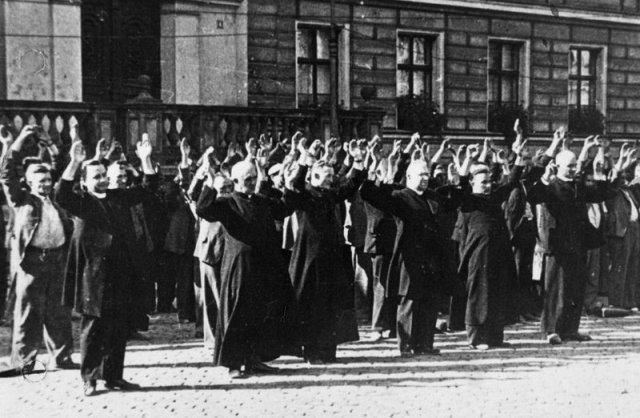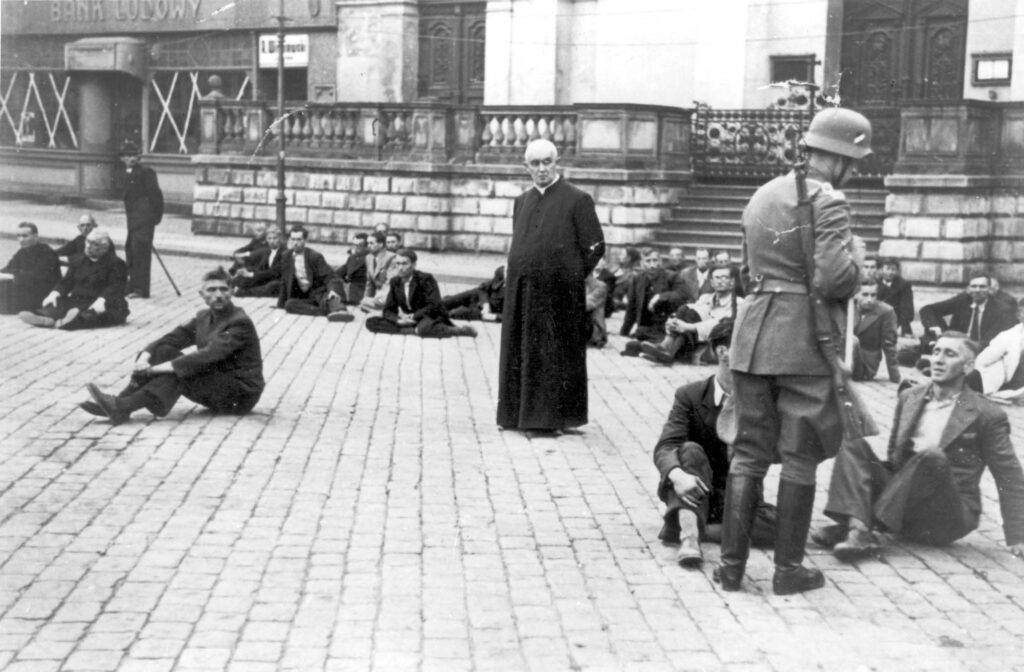Polish Church remembers murdered priests (EN + IT)


Ostaggi polacchi, tra cui preti cattolici, a Bydgoszcz, Polonia. Settembre 1939, credito foto dominio pubblico
Remembering the priests who died during World War II, let us also pray for all those who die today,” says Archbishop Stanisław Gądecki, the President of the Polish Bishops’ Conference. On April 29th the national Day of Martyrdom of the Polish Clergy is celebrated.
*
Ricordando il clero ucciso durante la seconda guerra mondiale, preghiamo anche per tutti coloro che muoiono oggi – ha affermato l’Arcivescovo Stanisław Gądecki, Presidente della Conferenza Episcopale Polacca. Il 29 aprile è la Giornata Nazionale del Martirio del Clero Polacco.
Established in 2002 by the Polish Episcopate, the commemoration day of the miraculous salvation of Polish priests, prisoners of the Dachau concentration camp, thanks to the intercession of St. Joseph, is intended to commemorate the priests who were victims of totalitarian systems, especially of Nazism and Communism.
On the occasion of the Day of Martyrdom of the Polish Clergy during World War II and the anniversary of the liberation of the Dachau concentration camp, Archbishop Stanisław Gądecki encourages all to pray for peace in the world. “The wars that break out in the 21st century show that there are still people who, disregarding others, pursue their goals, destroying everything and everyone that stands in their way,” the Archbishop points out.
The nationwide celebrations on this occasion will be held, as every year, in the Sanctuary of St. Joseph in Kalisz. Through his intercession the prisoners of Dachau asked for this place of extermination to be closed. They vowed that if they survived, they would make annual pilgrimages to St. Joseph’s Church.
The fight against the Polish elite
The Dachau camp was liberated on 29th April 1945. The surviving priests fulfilled their pledge until the end of their lives and made pilgrimages to Kalisz, to give thanks for their survival. The last of them, Fr. Leon Stępniak, died in 2013. Dachau is above all a symbol of the martyrdom of Polish priests.
As Dr. Paweł Więckowski, a historian from the Academy of Military Arts in Warsaw, highlights, the fight led by the Germans against the Polish Catholic Church lasted from the first days of the German occupation and had exterminatory implications.
-The Polish clergy was for the Germans a symbol of Polishness, which had to be erased according to the German national socialist racial idea, explains Dr. Paweł Więckowski.
The historian explains that for the Germans the fight against Polishness was a fight against the Polish elite – the murder of Polish priests, doctors, teachers, scientists, judges, lawyers and artists was to turn Poles into – in Hitler’s opinion – “a shapeless mass of sub-humans”. It is estimated that under the German occupation, between 1939 and 1945, about 3000 priests died at the hands of the Germans, as a result of public executions and deportation to concentration camps, and between 1939 and 1941 at the hands of the Soviets – 1000 Catholic priests and about 870 priests of other denominations perished.
Dr. Więckowski: “Polish priests were treated worse than priests of other nationalities”.
Dr. Paweł Więckowski points out that nuns also suffered a severe fate. They were detained in concentration camps and forced to perform hard labour.
-During World War II, about a quarter of Polish clergy died at the hands of both the Germans and the Soviets,’ emphasizes the historian.
The assistant professor of the Academy of Military Art in Warsaw explains that since December 1940 the Germans had started to gather the clergy that opposed Nazism in the so-called ‘Priesterblock’ in Dachau. They were brought in from other detention centres, prisons and concentration camps. -2720 clergymen were imprisoned there, of whom as many as 95 percent were Catholics, which means that Catholicism was the religion most severely repressed by German Nazism,” says Dr. Więckowski.
He notes that among the imprisoned priests the largest number were Poles – as many as 1780, of whom 868 died or were murdered.
The historian says that Polish priests were treated much worse than priests of other nationalities. They posed the greatest threat to Germany on its way to building a Germanic empire in the East.
Pastoral work in complete secrecy
-Dachau did not only hold Catholic priests. There were also imprisoned 109 Evangelicals pastors, 22 Orthodox priests, 8 Old Catholics and Mariavites pastors and two Muslim mullahs – adds Dr. Więckowski.
He stresses that their pastoral service was carried out in full conspiracy. -The priests also tried to bring comfort and spiritual care to other prisoners,” says Dr. Paweł Więckowski.
The 77th anniversary of the miraculous salvation of Polish priests, prisoners of the concentration camp in Dachau, thanks to St. Joseph, will be concluded by the Eucharist presided over by Bishop Krzysztof Wętkowski, Bishop of Włocławek, within the walls of the National Sanctuary of St. Joseph in Kalisz.

Polacchi arrestati in attesa di essere fucilati a Bydgoszcz (settembre 1939), photo credit dominio pubblico
*
Istituita nel 2002 dall’Episcopato Polacco a memoria del miracoloso salvataggio per intercessione di S. Giuseppe, dei sacerdoti polacchi prigionieri del campo di concentramento di Dachau, commemora i sacerdoti vittime dei sistemi totalitari, in particolare del nazismo e del comunismo.
In occasione della Giornata del Martirio del Clero Polacco durante la seconda guerra mondiale e dell’anniversario della liberazione del campo di concentramento di Dachau, l’Arcivescovo Stanisław Gądecki ha invitato a pregare per la pace nel mondo. “Le guerre che scoppiano nel XXI secolo mostrano che ci sono ancora persone che, indipendentemente dagli altri, perseguono i loro obiettivi, distruggendo tutto e tutti coloro che si frappongono sulla loro strada” – ha affermato il Prelato.
Le celebrazioni nazionali di questa Giornata si terranno, come ogni anno, presso il Santuario di S. Giuseppe a Kalisz. I prigionieri di Dachau chiesero la sua intercessione per la liquidazione del luogo di sterminio. Promisero che se fossero sopravvissuti, avrebbero fatto ogni anno un pellegrinaggio alla Chiesa di S. Giuseppe.
Lotta contro l’élite polacca
Il campo di concentramento di Dachau fu liberato il 29 aprile 1945. I sacerdoti sopravvissuti mantennero la loro promessa fino alla fine della loro vita e si recarono in pellegrinaggio a Kalisz, ringraziando per essere stati salvati. L’ultimo di loro, don Leon Stępniak è morto nel 2013. Dachau è prima di tutto un simbolo del martirio dei sacerdoti polacchi.
Il dottor Paweł Więckowski, storico dell’Accademia delle Arti Militari di Varsavia, ha sottolineato che la lotta contro la Chiesa cattolica polacca fu condotta dai tedeschi fin dai primi giorni dell’occupazione tedesca ed ebbe il tono dello sterminio.
Il clero polacco era per i tedeschi il simbolo dell’essere polacchi, e doveva essere spazzato via secondo l’idea razziale nazionalsocialista tedesca – ha spiegato il dr Paweł Więckowski.
Lo storico ha chiarito che la lotta contro l’essere polacchi era per i tedeschi una lotta contro le élite polacche. L’uccisione di sacerdoti, medici, insegnanti, scienziati, giudici, avvocati e artisti polacchi avrebbe dovuto rendere i polacchi – a giudizio di Hitler: “una massa informe di subumani”. Si stima che durante l’occupazione tedesca, tra il 1939 e il 1945, a seguito di esecuzioni pubbliche e deportazioni nei campi di concentramento, per mano dei tedeschi, vennero uccisi circa 3.000 ecclesiastici, mentre negli anni 1939-1941 per mano dei sovietici – circa 1.000 sacerdoti cattolici e circa 870 ecclesiastici di altre fedi.
Il Dr Więckowski: “I preti polacchi sono stati trattati peggio di quelli di altre nazioni”.
Il dr Paweł Więckowski ha sottolineato che anche le suore hanno subito un duro destino. Furono internate nei campi di concentramento, costrette a lavori massacranti.
-Durante la seconda guerra mondiale, per mano dei tedeschi è stato ucciso circa 1/4 del clero polacco – ha sottolineato lo storico.
Un assistente professore dell’Accademia d’Arte Militare di Varsavia ha spiegato che dal dicembre 1940 i tedeschi iniziarono a radunare sacerdoti contrari al nazismo nel cosiddetto “Priesterblock” a Dachau. Vi sono stati condotti da altri centri di detenzione, prigioni e da campi di concentramento. Lì furono rinchiusi 2.720 sacerdoti, il 95% dei quali erano cattolici, il che significa che il cattolicesimo era la religione più severamente repressa dal nazismo tedesco – ha affermato il dr Więckowski.
Ha fatto notare che tra i sacerdoti imprigionati, i polacchi erano i più numerosi: ben 1.780, di cui 868 morirono o furono uccisi.
Lo storico racconta che i sacerdoti polacchi furono trattati molto peggio di quelli di altre nazioni. Essi rappresentavano la più grande minaccia per la Germania nel suo cammino verso la costruzione dell’impero germanico in Oriente.
Il servizio pastorale in piena cospirazione
– A Dachau era detenuto non solo il clero cattolico. Furono imprigionati anche 109 evangelici, 22 cristiani ortodossi, 8 antichi cattolici e mariaviti e due mullah musulmani – ha aggiunto il dott. Więckowski.
Ha sottolineato che il loro servizio pastorale è stato svolto in piena cospirazione. I sacerdoti hanno cercato anche di portare conforto e protezione spirituale ad altri prigionieri – ha affermato il dr Paweł Więckowski.
Il momento culminante del 77.mo anniversario del miracoloso salvataggio per intercessione di S. Giuseppe, dei sacerdoti polacchi, prigionieri del campo di concentramento di Dachau, è l’Eucaristia presieduta dal vescovo Krzysztof Wętkowski – vescovo di Włocławek – dentro le mura del Santuario Nazionale di S. Giuseppe a Kalisz.



Dodaj komentarz